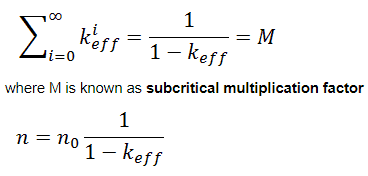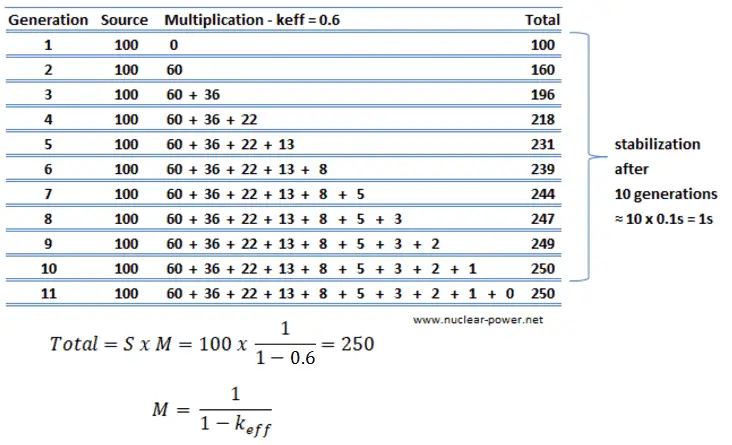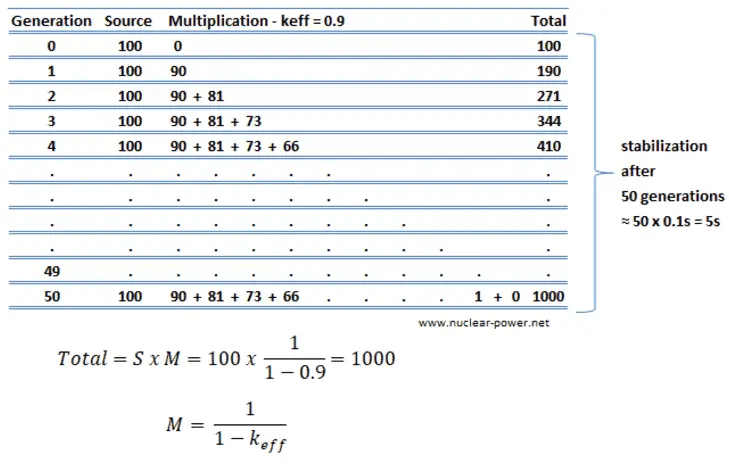For a defined source strength of n0 neutrons per neutron generation, the neutron population (i.e., the neutron flux) is given by:
where, n0 are source neutrons (0. generation) and n0keffi are neutrons from i-th generation. As i goes to infinity, the sum of this geometric series is (for keff < 1):
As can be seen, the neutron population of a subcritical reactor with source neutrons does not drop to zero, the neutron population stabilizes itself at level n, which is equal to source multiplied by factor M.
Example: Subcritical Multiplication Factor
keff = 0.6
Consider a reactor in which:
- keff = 0.6
- the mean neutron generation to be ld = 0.1s
- the external source provides n0 = 100 neutrons/s.
When 100 neutrons are suddenly introduced into the reactor via source n0, these neutrons will produce 60 neutrons (100 x 0.6) from fission to start the next generation. The duration of each neutron generation is equal to ld = 0.1s. From 60 neutrons of the second generation, the system will produce 36 neutrons (60 x 0.6) to start the third generation (during ld = 0.1s). The number of neutrons produced by fission in subsequent generations due to the introduction of 100 source neutrons into the reactor is shown in the figure.
As can be seen, the neutron population stabilizes itself at level n = 250, which is equal to source multiplied by factor M. The addition of source neutrons to the reactor containing fissionable material has the effect of maintaining a much higher stable neutron level due to the fissions occurring than the neutron level that would result from the source neutrons alone. As can be seen, the amount of time it takes to reach the steady-state neutron level is approximately equal to the time of 10 neutron generations (i.e., 10 x 0.1s = 1s).
Now, we will illustrate what happens to the neutron population when the value of keff is changed. For example, during a reactor startup, an initially subcritical reactor is driven to criticality via a series of discrete control rod withdrawals. During these withdrawals a reactivity increases. After each control rod withdrawal, the operator must wait to allow the reactor to attain the steady-state neutron level. The amount of time it takes to reach the steady-state neutron level after a reactivity change increases as keff approaches the critical state.
keff = 0.9
Consider a reactor in which:
- keff = 0.9
- the mean neutron generation to be ld = 0.1s
- The external source provides n0 = 100 neutrons/s.
When 100 neutrons are suddenly introduced into the reactor via source n0, these neutrons will produce 90 neutrons (100 x 0.9) from fission to start the next generation. The duration of each neutron generation is equal to ld = 0.1s. From 90 neutrons of the second generation, the system will produce 81 neutrons (90 x 0.9) to start the third generation (during ld = 0.1s). The number of neutrons produced by fission in subsequent generations due to the introduction of 100 source neutrons into the reactor is shown in the figure.
As can be seen, the neutron population stabilizes itself at level n = 1000, which is equal to source multiplied by factor M. As can be seen, the amount of time it takes to reach the steady-state neutron level is significantly higher since it is approximately equal to the time of 50 neutron generations (i.e., 50 x 0.1s = 5s). The reason is evident in the series expression in the figure for keff = 0.9. As keff increases, more terms in the series are significant, meaning that more previous generations of source neutrons contribute to the present population.
Summary
Therefore, during a reactor startup, the value of keff increases and:
- the steady-state neutron level increases (by factor M)
- time of stabilization increases (let say 1/100 = keffi → tstab = ln(0.01) / ln (keff) x ld)
It must be noted, the real PWR cores reach reactivities around keff = 0.92 – 0.95 at the beginning of the reactor startup. Values around 0.6 are not common.



